|
|

|
|
Author
|
Topic: Polaris Dawn private SpaceX mission
|
Robert Pearlman
Editor Posts: 53147
From: Houston, TX
Registered: Nov 1999
|
 posted 02-14-2022 07:27 AM
posted 02-14-2022 07:27 AM
   
Polaris Program Polaris Program will Undertake a Series of Pioneering SpaceX Dragon Missions, Demonstrating New Technologies and Culminating in the First Human Spaceflight on StarshipLed by tech entrepreneur and Inspiration4 commander Jared Isaacman, this program will advance deep space exploration while raising global awareness for St. Jude Children's Research Hospital. 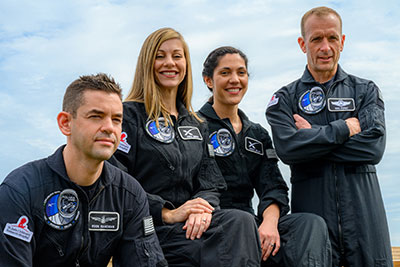 Above: Polaris Dawn crew members Jared Isaacman, Anna Menon, Sarah Gillis and Scott "Kidd" Poteet. (CREDIT: Pplaris Program/Jared Kraus) Today (Feb. 14), Jared Isaacman, founder and CEO of Shift4, announced the Polaris Program, a first-of-its-kind effort to rapidly advance human spaceflight capabilities, while continuing to raise funds and awareness for important causes here on Earth. The program will consist of up to three human spaceflight missions that will demonstrate new technologies, conduct extensive research, and ultimately culminate in the first flight of SpaceX's Starship with humans on board. The first mission, Polaris Dawn, is targeted for no earlier than the fourth quarter of this year and will be commanded by Isaacman, an accomplished pilot and astronaut who led Inspiration4, the world's first all-civilian mission to orbit that helped raise over $240 million for St. Jude Children's Research Hospital. "The Polaris Program is an important step in advancing human space exploration while helping to solve problems through the use of innovative technology here on Earth," said Isaacman. "On Polaris Dawn, we endeavor to achieve the highest Earth orbit ever flown in addition to conducting the world's first commercial spacewalk and testing of Starlink laser-based communication. Alongside these important objectives, we will be supporting scientific research to advance both human health interests on Earth and our understanding of human health during future long-duration spaceflights." Building upon the Inspiration4 mission, Polaris Dawn will continue to raise funds and awareness for St. Jude Children's Research Hospital. The Polaris Dawn Mission SpaceX's Falcon 9 rocket will launch the Polaris Dawn mission from Launch Complex 39A at Kennedy Space Center in Florida. Dragon and the Polaris Dawn crew will spend up to five days in orbit, flying higher than any Dragon mission to date and endeavoring to reach the highest Earth orbit ever flown. While in orbit, SpaceX mission control will carefully monitor Dragon and the crew as they: – Attempt the first-ever commercial spacewalk with SpaceX-designed extravehicular activity (EVA) spacesuits, upgraded from the current intravehicular (IVA) suit. The development of this suit and the execution of the EVA will be important steps toward a scalable design for spacesuits on future long-duration missions. - Become the first crew to test Starlink laser-based communications in space, providing valuable data for future space communications systems necessary for human spaceflight to the Moon, Mars, and beyond.
- Conduct scientific research designed to advance both human health on Earth and our understanding of human health during future long-duration spaceflights. This includes, but is not limited to:
- Using ultrasound to monitor, detect, and quantify venous gas emboli (VGE), contributing to studies on human prevalence to decompression sickness;
- Gathering data on the radiation environment to better understand how space radiation affects human biological systems;
- Providing biological samples towards multi-omics analyses for a long-term Biobank; and
- Research related to Spaceflight Associated Neuro-Ocular Syndrome (SANS), which is a key risk to human health in long-duration spaceflight.
SpaceX and Polaris Dawn will also collaborate with the Translational Research Institute for Space Health (TRISH), BioServe Space Technologies at the University of Colorado Boulder, Space Technologies Lab at Embry Riddle Aeronautical University, Weill Cornell Medicine, Johns Hopkins University Applied Physics Laboratory, the Pacific Northwest National Laboratory, and the U.S. Air Force Academy. The Polaris Dawn Crew 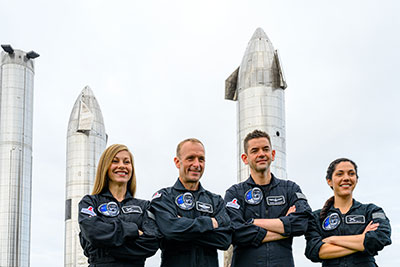 Above: Polaris Dawn crew members Anna Menon, Scott "Kidd" Poteet, Jared Isaacman and Sarah Gillis. (CREDIT: Pplaris Program/Jared Kraus) The Polaris Dawn mission has many first-time objectives, so the Polaris Program chose a crew of experts who know each other well and have a foundation of trust they can build upon as they undertake the challenges of this mission. The crew includes: Mission Commander, Jared "Rook" Isaacman
In addition to commanding Inspiration4, Isaacman has over 7,000 flight hours of aviation experience, including ratings in multiple experimental and ex-military aircraft. He set speed-around-the-world records in 2008 and 2009, as well as 100 air show performances as a member of the Black Diamond Jet Team, all of which were dedicated to charitable causes. In 2011, Isaacman co-founded what would become the world's largest private air force, Draken International, to provide realistic adversary training for the United States Department of Defense. - Mission Pilot, Scott "Kidd" Poteet
Poteet is a retired U.S. Air Force Lieutenant Colonel who served 20 years in various roles to include Commander of the 64th Aggressor Squadron, USAF Thunderbird Demonstration Pilot, #4 Slot, USAF Weapons School Graduate, Operational Test and Evaluation Pilot, and F-16 Flight Examiner. Kidd is a command pilot with over 3,200 flying hours in the F-16, A-4, T-38, T-37, T-3 and Alpha Jet. He logged over 400 hours of combat time in support of various Operations around the world. Following his Air Force career, Kidd served as the Director of Business Development at Draken International as well as the Vice President of Strategy at Shift4 Payments. He most recently served as the Mission Director of Inspiration4. - Mission Specialist, Sarah Gillis
Gillis is a Lead Space Operations Engineer at SpaceX, responsible for overseeing the company's astronaut training program. This includes the development of mission-specific curriculum and training execution for both NASA and commercial astronauts who fly aboard the Dragon spacecraft. She prepared NASA astronauts for the first Demo-2 and Crew-1 missions, and most recently directly trained the Inspiration4 astronauts, the first all civilian crew to go to orbit. Sarah is an experienced mission control operator, who has supported real-time operations for Dragon's cargo resupply missions to and from the International Space Station as a Navigation Officer, and as a crew communicator for Dragon's human spaceflight missions. - Mission Specialist & Medical Officer, Anna Menon
Menon is a Lead Space Operations Engineer at SpaceX, where she manages the development of crew operations and serves in mission control as both a Mission Director and crew communicator. During her tenure at SpaceX, Menon has led the implementation of Dragon's crew capabilities, helped create the crew communicator operator role, and developed critical operational responses to vehicle emergencies, such as a fire or cabin depressurization. Anna served in mission control during multiple cargo and crew Dragon missions, including Demo-2, Crew-1, CRS-22, and CRS-23. Prior to SpaceX, she worked for seven years at NASA as a biomedical flight controller for the International Space Station. |
Robert Pearlman
Editor Posts: 53147
From: Houston, TX
Registered: Nov 1999
|
 posted 08-21-2024 03:44 PM
posted 08-21-2024 03:44 PM
   
From Polaris Program (via X): The Polaris Dawn crew [on Monday, Aug. 19] arrived at Kennedy Space Center. 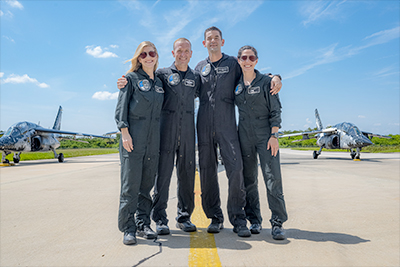 From SpaceX (via X): Dragon arrived at our hangar at Pad 39A ahead of Falcon 9's launch of Polaris Dawn. 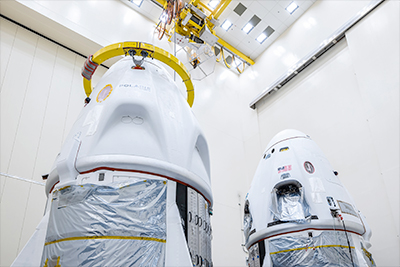 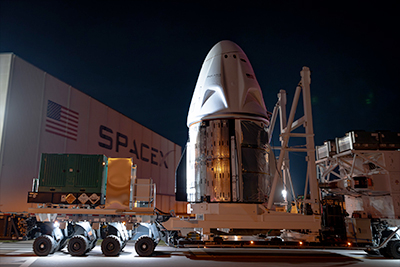
|
Robert Pearlman
Editor Posts: 53147
From: Houston, TX
Registered: Nov 1999
|
 posted 08-24-2024 09:15 PM
posted 08-24-2024 09:15 PM
   
From SpaceX (via X): Falcon 9 and Dragon vertical at pad 39A in Florida. 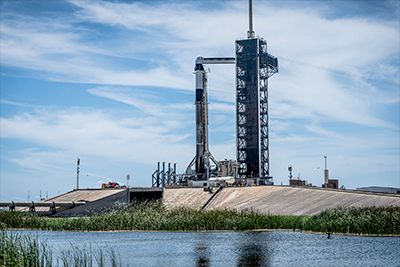 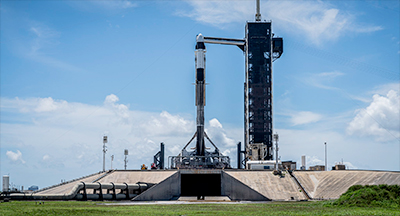
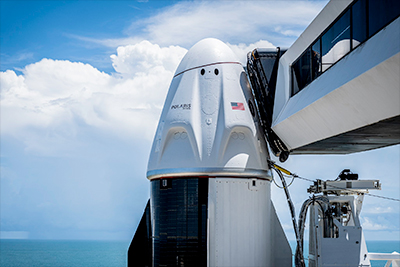
|
Robert Pearlman
Editor Posts: 53147
From: Houston, TX
Registered: Nov 1999
|
 posted 08-25-2024 08:46 AM
posted 08-25-2024 08:46 AM
   
From SpaceX (via X): Polaris Dawn and SpaceX completed a full rehearsal of launch day activities ahead of liftoff on Tuesday.Static fire test of Falcon 9 complete — targeting Tuesday, August 27 at 3:38 a.m. ET for launch of the Polaris Program’s Polaris Dawn mission. 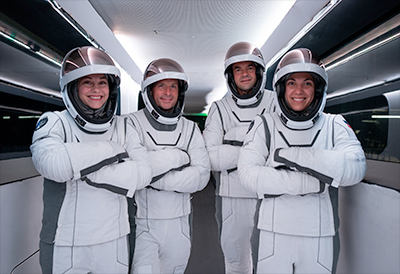 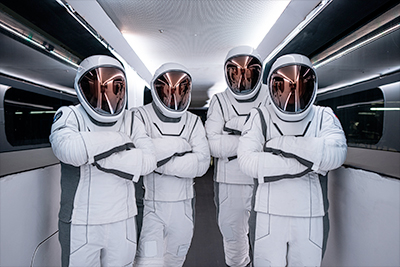
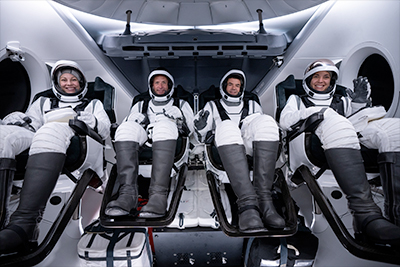
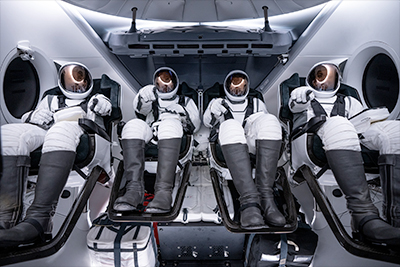
|
Robert Pearlman
Editor Posts: 53147
From: Houston, TX
Registered: Nov 1999
|
 posted 09-10-2024 04:40 AM
posted 09-10-2024 04:40 AM
   
SpaceX launches Polaris Dawn crew on private record-chasing missionA four-person crew has lifted off on a privately-funded mission that will attempt the first commercial spacewalk and test other technologies for the future of commercial spaceflight. 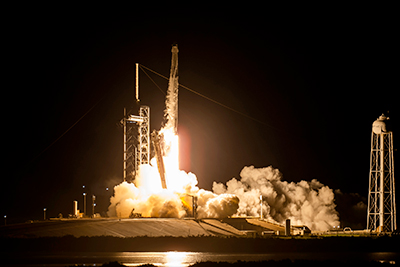 Polaris Dawn commander Jared Isaacman, pilot Scott "Kidd" Poteet and mission specialists Sarah Gillis and Anna Menon launched aboard the Crew Dragon "Resilience" atop a SpaceX Falcon 9 rocket on Tuesday (Sept. 10). The four private astronauts took flight at 5:23 a.m. EDT (0923 GMT) from Pad 39A at NASA's Kennedy Space Center in Florida. The planned five-day mission in Earth orbit will include an attempt at achieving the highest altitude of any human spaceflight mission since the Apollo program; testing SpaceX's first extravehicular spacesuit during the world's first commercial spacewalk; and demonstrating a new communication system using the Starlink satellite constellation. There will also be an on-orbit reading of a children's book, "Kisses from Space," written by Menon; and a musical performance on violin by Gillis. The four crewmembers will conduct nearly 40 critical health research experiments, all while raising funds for St. Jude Children's Research Hospital. "After more than two years of training, we are excited to embark on this mission," said Isaacman, who is underwriting the Polaris Program, a series of three spaceflights beginning with Polaris Dawn. "We are incredibly thankful for this opportunity and to the thousands of SpaceX engineers who have contributed to this endeavor." 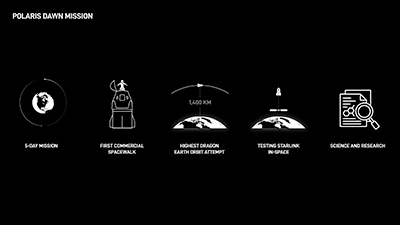 "We hope the results from our mission will accelerate SpaceX's vision to make life multiplanetary and support St. Jude Children's Research Hospital and its efforts to improve global survival rates for childhood cancer and other life-threatening diseases. Throughout our mission, we will aim to inspire humankind to look up and imagine what we can achieve here on Earth and in the worlds beyond our own," he said. "Resilience," the Dragon supporting Polaris Dawn, previously flew Crew-1 to and from the International Space Station, and Inspiration4, the first all-civilian mission to orbit. The Falcon 9's first stage previously launched Crew-8 and two Starlink missions. Following separation, it landed on the "Just Read the Instructions" droneship stationed in the Atlantic Ocean. |
Robert Pearlman
Editor Posts: 53147
From: Houston, TX
Registered: Nov 1999
|
 posted 09-10-2024 03:08 PM
posted 09-10-2024 03:08 PM
   
Polaris Program release Polaris Dawn Flight Day 1 UpdateThe Polaris Dawn crew completed their first day on-orbit, also known as Flight Day 1. After a successful launch by SpaceX’s Falcon 9 rocket to low-Earth orbit from Launch Complex 39A at NASA’s Kennedy Space Center in Florida at 5:23 a.m. ET, the crew took off their spacesuits and began their multi-day mission. 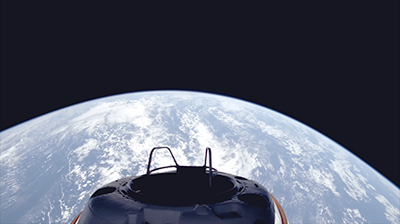 Above: View of Earth and Dragon’s Skywalker shortly after the Polaris Dawn crew launched into an orbit of about 190 x 1,216 km. (SpaceX) Shortly after liftoff, the crew began a two-day pre-breathe protocol in preparation for their anticipated spacewalk on Thursday, September 12 (Flight Day 3). During this time, Dragon’s pressure slowly lowers while oxygen levels inside the cabin increase, helping purge nitrogen from the crew’s bloodstreams. This will help lower the risk of decompression sickness (DCS) during all spacewalk operations. About two hours into Flight Day 1, the crew enjoyed their first on-orbit meals before engaging in the mission’s first science and research block and testing Starlink, which lasted about 3.5 hours. Dragon made its first pass through the South Atlantic Anomaly (SAA), a region where Earth’s magnetic field is weaker, allowing more high-energy particles from space to penetrate closer to Earth. Mission control operators and the crew worked closely to monitor and respond to the vehicle’s systems across all high-apogee phases of flight, particularly through the SAA region. Mid-day, the crew settled in for their first sleep period in space, during which Dragon will perform its first apogee raising burn. Orbiting Earth higher than any humans in over 50 years, the crew will rest for about eight hours ahead of a busy day on Flight Day 2. Most excitingly, during its first orbit, Dragon reached an apogee of approximately 1,216 kilometers, making Polaris Dawn the highest Dragon mission flown to date. Following a healthy systems checkout, the crew and mission control will monitor the spacecraft ahead of the vehicle raising itself to an elliptical orbit of 190 x 1,400 kilometers at the start of Flight Day 2. |
Robert Pearlman
Editor Posts: 53147
From: Houston, TX
Registered: Nov 1999
|
 posted 09-10-2024 08:30 PM
posted 09-10-2024 08:30 PM
   
collectSPACE Polaris Dawn crew orbits higher above Earth than 1966 Gemini 11 recordA commercial space crew has flown higher above Earth than anyone who has traveled since the last Apollo astronauts went to the moon. The four members of the Polaris Dawn mission, riding aboard SpaceX's Dragon spacecraft "Resilience," climbed into an elliptical orbit with a high point, or apogee, of 870 miles (1,400.7 kilometers) on Tuesday (Sep. 10). They reached the record distance about 12 hours after lifting off at 5:23 a.m. EDT (0923 GMT) from Florida earlier in the day and circling the planet about eight times in an initial orbit of 118 by 746 miles (190 by 1,200 km). 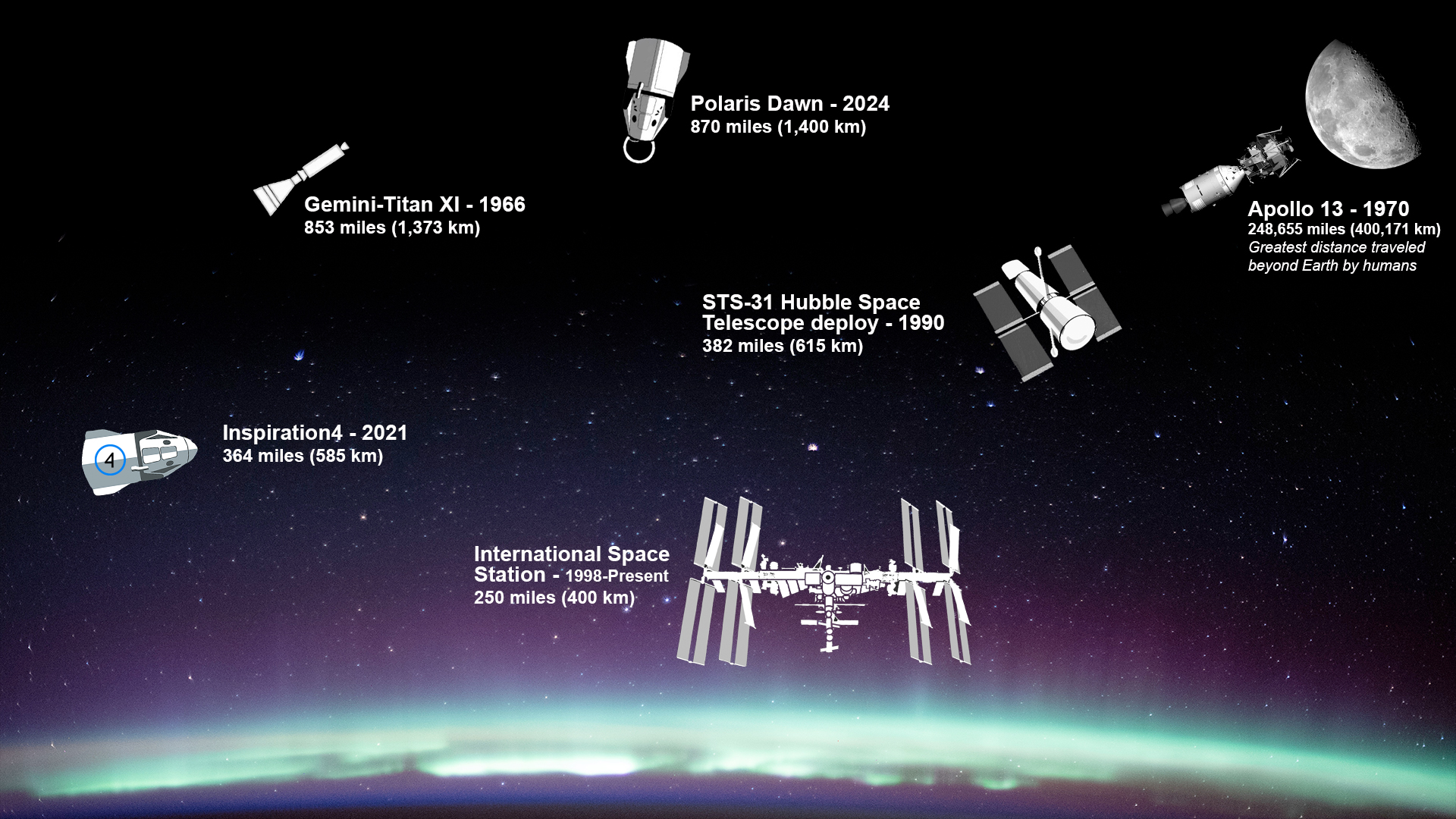 |
Robert Pearlman
Editor Posts: 53147
From: Houston, TX
Registered: Nov 1999
|
 posted 09-11-2024 08:40 PM
posted 09-11-2024 08:40 PM
   
Polaris Program release Polaris Dawn Flight Day 2 UpdateThe Polaris Dawn crew began Flight Day 2 with an incredible milestone – Dragon reached an apogee of more than 1,400 kilometers, marking the farthest humans have traveled in space since the completion of the Apollo program over 50 years ago. Mission Specialist Sarah Gillis and Mission Specialist and Medical Officer Anna Menon also became the first two women to have travelled this far in space! Mission Commander Jared Isaacman also passed the torch to the NASA Artemis crew, saying he’s looking forward to their upcoming flight. 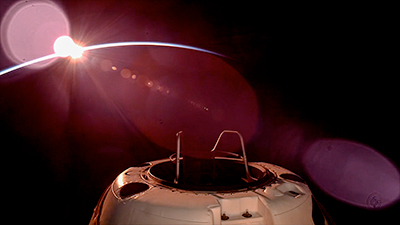 After completing six orbits of Earth at this altitude, Dragon performed a series of descent burns to reach an orbit of ~190 x 700 km for Thursday’s spacewalk while simultaneously continuing to safely lower its interior’s pressure, bringing the cabin environment closer to conditions required for the EVA. The crew also spent a few hours demonstrating the suit’s pressurized mobility, verifying positions and accessibility in microgravity along with preparing the cabin for the EVA.
In addition to EVA prep, the crew conducted a series of activities on-orbit, including time dedicated to science and research. The crew focused on monitoring initial changes to eye sight and ocular health, studying how fluid shifts and exposure to microgravity affect blood flow, and assessed how medications are processed by the body while on-orbit. 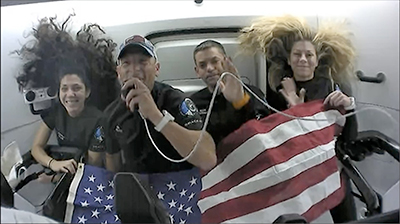 The entire crew met with representatives from Folds of Honor — an organization providing educational scholarships to spouses and children of America's fallen and disabled military service-members and first responders — honoring those who have made the ultimate sacrifice in service of the United States. 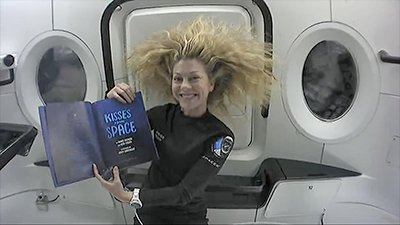 Anna then read her book, Kisses from Space, to a group of St. Jude patients and her family, followed by a Q&A session. Olympic gold medalist Shawn Johnson East joined the crew via video transmission to host the book reading. 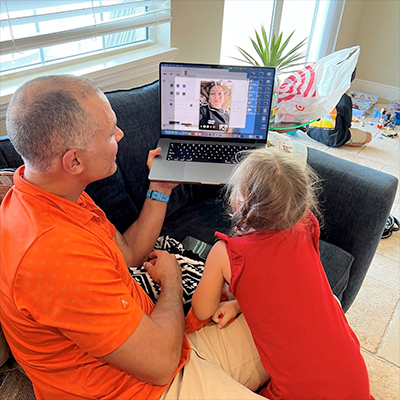 Jared, Kidd, Sarah, and Anna ended their day with individual family calls conducted over Starlink connections and preparing a special message for fans later in the mission before settling in for a good night’s sleep ahead of tomorrow’s world-first commercial spacewalk. |
Robert Pearlman
Editor Posts: 53147
From: Houston, TX
Registered: Nov 1999
|
 posted 09-12-2024 07:18 AM
posted 09-12-2024 07:18 AM
   
collectSPACE Polaris Dawn astronauts 'stand up' on first commercial spacewalkTwo private astronauts conducting the first commercial spacewalk did not so much float out of their spacecraft as they did "stand up." Polaris Dawn crewmates Jared Isaacman and Sarah Gillis took turns emerging from the upper hatch of SpaceX's Dragon spacecraft "Resilience" on Thursday (Sept. 12). It was the first time that non-government astronauts have left the protective confines of their vehicle for the vacuum of space. It was also the 20th stand-up extravehicular activity (SEVA) in history. 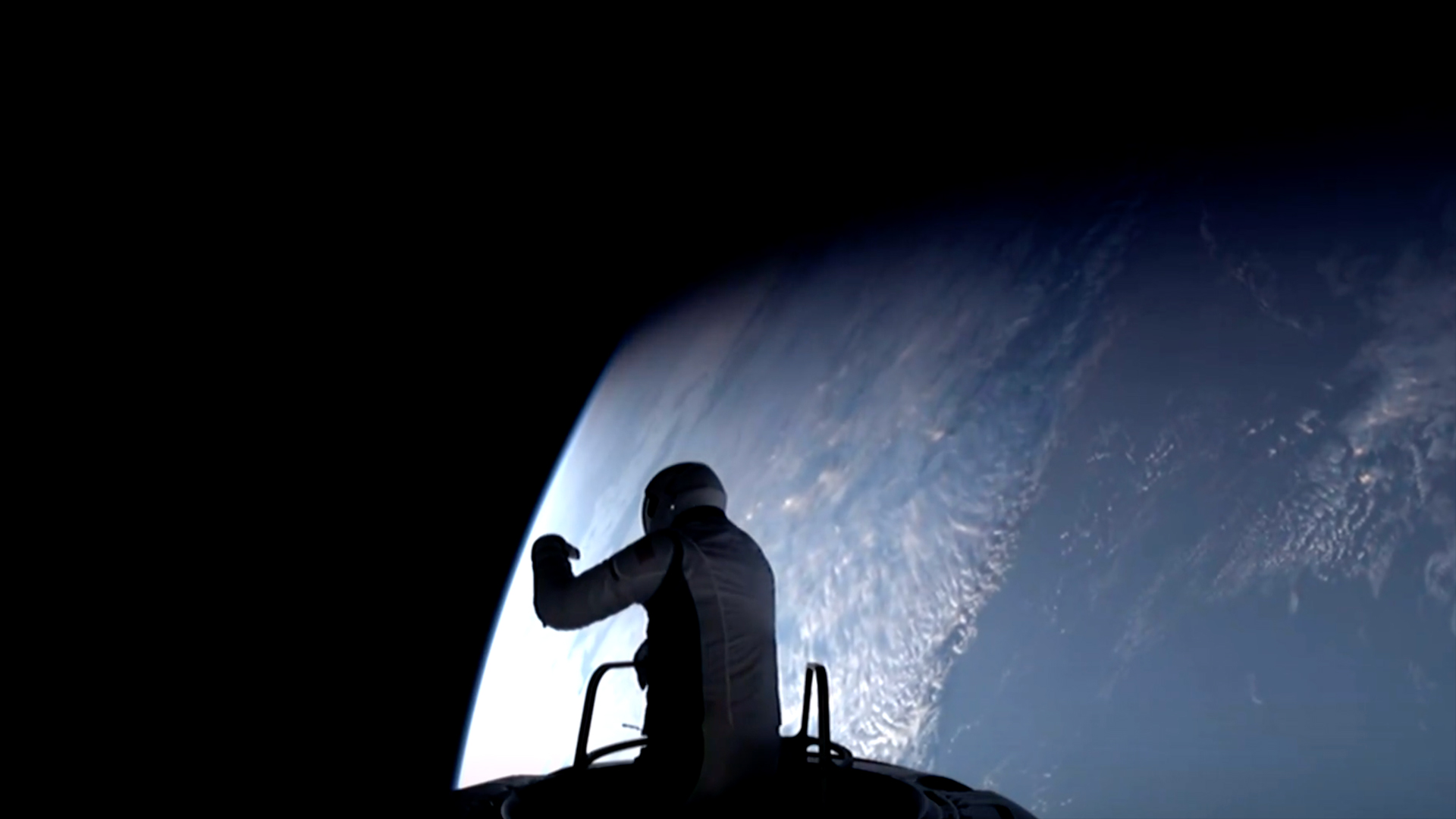 |
Robert Pearlman
Editor Posts: 53147
From: Houston, TX
Registered: Nov 1999
|
 posted 09-12-2024 04:37 PM
posted 09-12-2024 04:37 PM
   
Polaris Program release Polaris Dawn Flight Day 3 UpdateEarly Thursday morning (Sept. 12) at 7:58 a.m. ET, the Polaris Dawn crew successfully completed the world's first spacewalk — also known as an extravehicular activity (EVA) — from Dragon at 732.2 km above Earth. 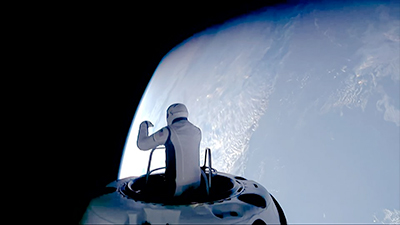 Shortly after arriving in space on Tuesday, the crew began a two-day pre-breathe process, designed to prevent decompression sickness while also preparing the crew for the environment inside the EVA suits by gradually lowering Dragon's cabin pressure and increasing the oxygen concentration.
Then on Thursday, the crew donned their suits and initiated Dragon seat rotation, suit tare, and the heads-up display and helmet camera checkouts. The 106-minute spacewalk officially began at 6:12 a.m. ET when suit pressurization started, the nitrogen purge was initiated, and pure oxygen (O2) was flowing into the suits. A secondary flow of oxygen primarily helped provide cooling to the suits, which would come in handy during the spacewalk. 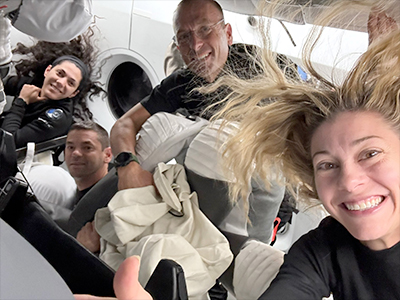 Once suit leak checks were complete, the crew and ground teams gave the go for Dragon to initiate venting, which took the cabin's pressure down from ~8 psi to below 1 psi – nearly to the vacuum of space. Simultaneously, Dragon repositioned its trunk to face the sun ahead of the hatch opening.
Mission Commander Jared Isaacman opened the hatch and for the first time, four astronauts were simultaneously exposed to the vacuum of space. Jared and Mission Specialist Sarah Gillis separately exited the spacecraft and individually performed a series of suit mobility demonstrations to test the performance of the spacesuit in the vacuum environment of space. Mission Pilot Kidd Poteet and Mission Specialist Anna Menon remained seated, managing suit umbilicals and monitoring vital support systems and telemetry on Dragon's displays. 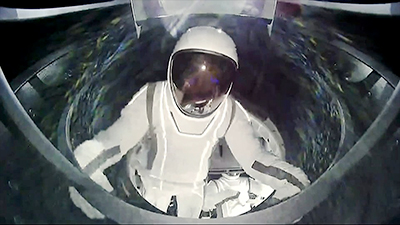 Upon completion of their individual EVAs, the hatch was closed, Dragon re-pressurized to 14 psi, cabin oxygen and pressure levels confirmed, officially completing the suit testing alongside the first commercial spacewalk and the first EVA from a Dragon spacecraft.
Throughout the EVA, stunning visuals were afforded by Dragon's cameras and the spacesuits helmet cameras as the crew orbited between 184.9 x 732.2 km above Earth.
Following the spacewalk, the crew took time to rest and recuperate, enjoying a well-deserved meal before posting from space for the first time on X using Starlink high-speed internet. The crew concluded the day by connecting with their families and settling in for their sleep period ahead of Flight Day 4. 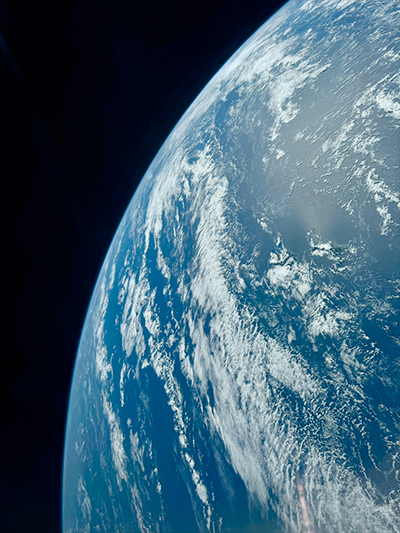 |
Robert Pearlman
Editor Posts: 53147
From: Houston, TX
Registered: Nov 1999
|
 posted 09-14-2024 07:52 AM
posted 09-14-2024 07:52 AM
   
Polaris Program release Polaris Dawn Flight Day 4 UpdateAfter an exciting and historic spacewalk on Thursday, September 12, the crew spent the majority of their Flight Day 4 focused on science and research. Polaris Dawn partnered with 31 institutions from across the world to create a robust and diverse science research portfolio throughout their time in space. 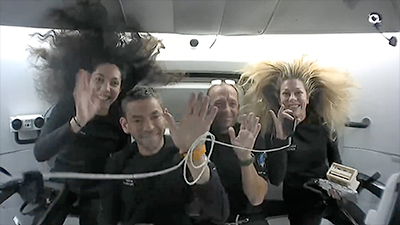 A few of the studies the crew has focused on since arriving on-orbit have included assessing the effects of microgravity on the human airway and veinous system in addition to examining how blood flow restriction alters blood flow in space using ultrasound and smart watches.
As humans become a spacefaring civilization, having the proper support system in the event of medical emergencies is key. The Polaris Dawn crew tested out Tempus Pro, a commercial off-the-shelf device that can collect and integrate measurements of health – including blood pressure, heart rate, respiration rate, temperature, and more – along with ultrasound imaging capabilities. The crew was able to use it to assess and compare vital sign data collected pre-flight to that collected during their time on-orbit. 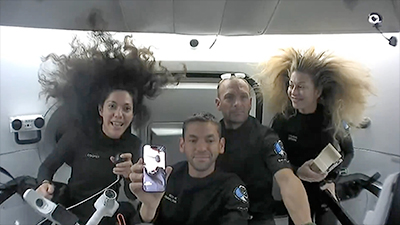 The crew is also working with several partners to study the effects of microgravity on ocular health to help contribute to both preventative and post-diagnosis treatments associated with Spaceflight Associated Neurocular Syndrome (SANS), which many astronauts have experienced from their time in space. Check out the science and research video we shared earlier today to learn more about what the crew has been up to!
The crew also continued to test and demonstrate Starlink aboard Dragon. One of the biggest tests of connectivity includes the ability to quickly share files. Earlier in the week, the crew recorded Mission Specialist Sarah Gillis playing "Rey's Theme" by John Williams on the violin. Once complete, the crew successfully sent the files down to Earth over Starlink to help create this special music event named "Harmony of Resilience." 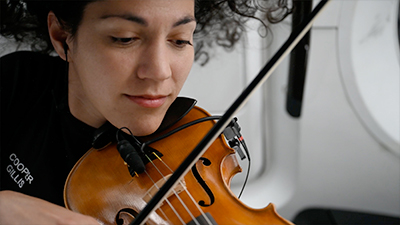 Teams on Earth synced Gillis's video and audio with various recorded orchestral performances around the globe, including in Los Angeles, which was attended by legendary composer John Williams and the entire Polaris Dawn crew. These performances were conducted from mid-2023 to early 2024.
The crew wrapped their day and are gearing up for their final day on-orbit, during which more research and Starlink testing will be conducted. 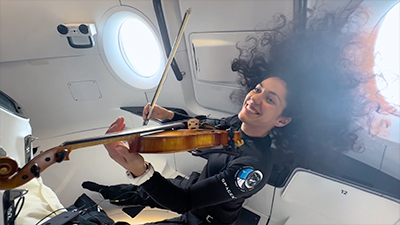 |
Robert Pearlman
Editor Posts: 53147
From: Houston, TX
Registered: Nov 1999
|
 posted 09-14-2024 09:43 PM
posted 09-14-2024 09:43 PM
   
Polaris Program release Polaris Dawn Flight Day 5 UpdateThe crew's final full day on-orbit was dedicated to furthering and finalizing the scientific goals of the Polaris Dawn mission, connecting with one of their training teams, and catching-up with the SpaceX family. 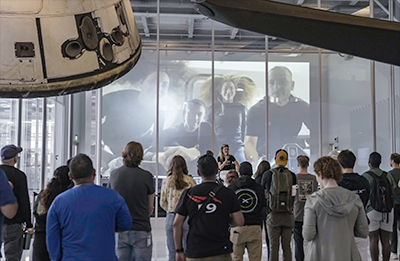 Two of the day's scientific highlights focused on preventative and life-saving studies – from identifying and understanding the risk of kidney stone formation while living in microgravity to developing and validating CPR (cardiopulmonary resuscitation) procedures aboard the Dragon spacecraft.
Throughout the day, the crew continued to test Starlink, including a 40+ minute, uninterrupted video call with SpaceX teams back on Earth, which took place as Dragon orbited across the U.S. Eastern Seaboard, the Atlantic Ocean, and the Cape of Good Hope. The plaser in Dragon's trunk and the partner Starlink satellite for the event maintained their laser link during 16 Draco thruster firings.
The crew also connected with members of the Air Force who helped train them for a week of solo skydiving at the United States Air Force Academy in Colorado.
Before settling in for their last sleep period of the mission, the crew took some time to connect with their families and began preparing Dragon's cabin for reentry and splashdown.
Dragon and the crew are set to return to Earth and splash down off the coast of Dry Tortugas, Florida on Sunday, September 15 at 3:36 a.m. ET. |
Robert Pearlman
Editor Posts: 53147
From: Houston, TX
Registered: Nov 1999
|
 posted 09-15-2024 03:06 AM
posted 09-15-2024 03:06 AM
   
collectSPACE 9 firsts in 5 days: Polaris Dawn crew lands from history-making SpaceX missionFour private astronauts are back on Earth after a five-day mission that set firsts and broke records in an effort to advance human spaceflight. Polaris Dawn mission commander Jared Isaacman, pilot Scott "Kidd" Poteet and mission specialists Sarah Gillis and Anna Menon splashed down on SpaceX's Dragon spacecraft "Resilience" in the Gulf of Mexico, off the southern tip of Florida on Sunday (Sept. 15). Their landing, at approximately 3:37 a.m. EDT (0737 GMT), brought to an end the first of three planned Polaris Program missions all being funded by Isaacman, a 41-year-old billionaire entrepreneur and private jet pilot. 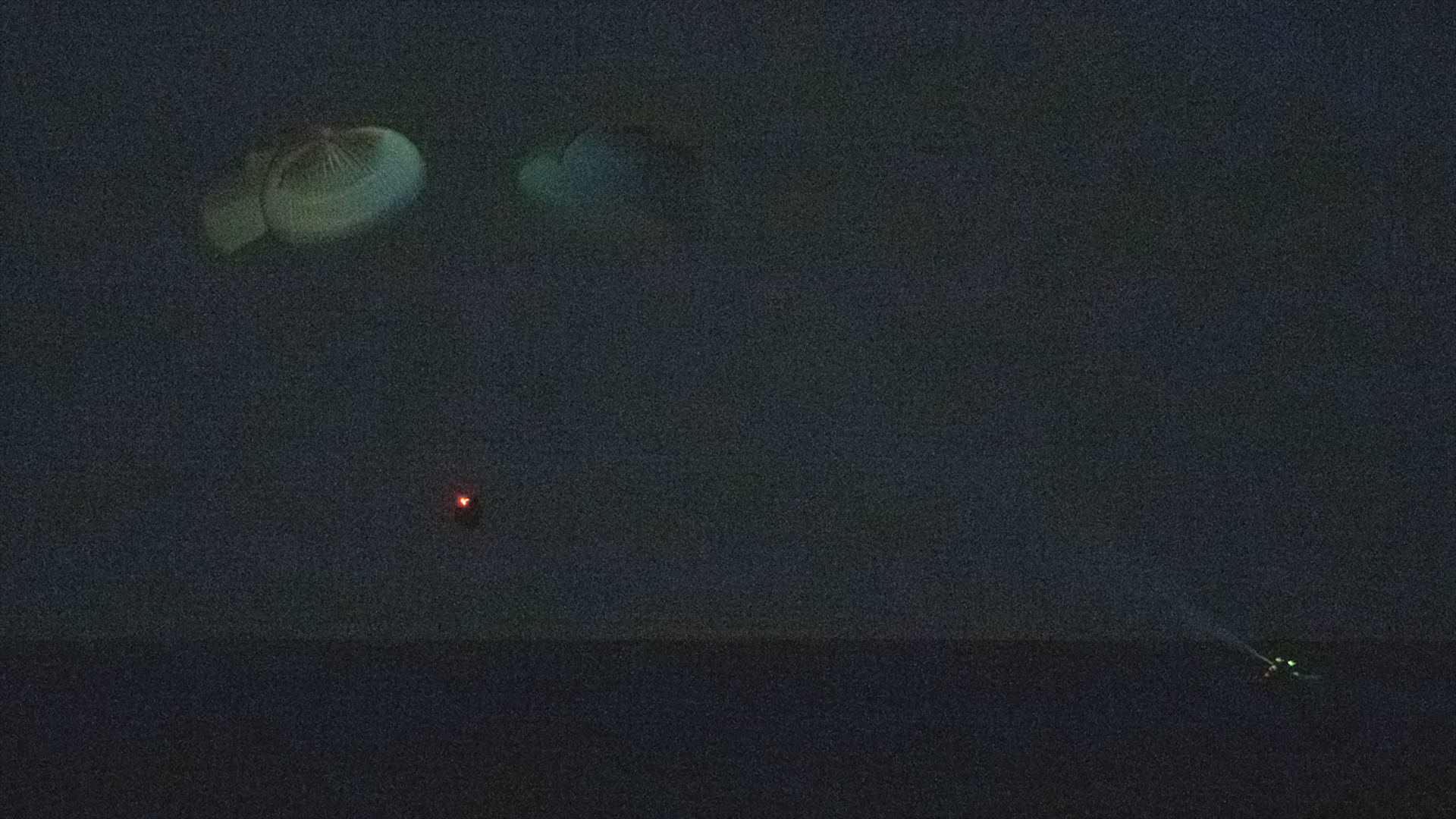 |
Robert Pearlman
Editor Posts: 53147
From: Houston, TX
Registered: Nov 1999
|
 posted 09-16-2024 11:44 AM
posted 09-16-2024 11:44 AM
   
Polaris Dawn release Polaris Dawn Crew Returns to Earth, Achieving Major Objectives During Their Five-Day MissionAfter nearly five days orbiting Earth, the astronauts of Polaris Dawn, flying aboard SpaceX's Dragon spacecraft, safely splashed down off the coast of Florida at 3:36:54 a.m. EDT. The mission launched on a SpaceX Falcon 9 rocket from Launch Complex 39A at NASA's Kennedy Space Center in Florida at 5:23 a.m. EDT on September 10, 2024. After SpaceX teams safely recovered Dragon, the crew flew to Kennedy Space Center to reunite with their families and complete initial medical checks ahead of flying to Houston, Texas, to complete more of the mission's research studies. The Polaris Dawn crew accomplished several historic milestones, including: - Flying higher than any previous Dragon mission to date and reaching the highest Earth orbit ever flown, all while moving through portions of the Van Allen radiation belt at an altitude of 1,408.1 kilometers (874.9 miles) from Earth's surface — or more than three times farther than the International Space Station. This was the highest altitude of any human spaceflight mission since the Apollo program;
- Completing the first-ever commercial space walk while traveling at 17,500 miles per hour in an elliptical orbit of approximately 190 x 700 kilometers (435 miles) above Earth with new SpaceX-designed extravehicular activity (EVA) spacesuits – the development of which will define future long-duration and scalable missions in space;
- Partnering with 31 global institutions to conduct approximately 36 experiments for critical scientific research designed to advance our knowledge of human health both on Earth and during future long-duration spaceflights;
- Testing laser-based satellite communication using optical links between the Dragon spacecraft and Starlink satellites, revolutionizing the speed and quality of space communications;
- Reading "Kisses From Space," a book written by Mission Specialist and Medical Officer Anna Menon to share with both her own family and several brave patients of St. Jude Children's Research Hospital®;
- Holding a special music moment to unite and inspire the world through the globally understood medium of music, while also fundraising for St. Jude and El Sistema USA. During the mission, Mission Specialist Sarah Gillis played the violin part from "Rey's Theme" by composer John Williams and sent the recording back to Earth using Starlink. She was joined in her performance by professional and youth musicians from around the world through a series of pre-recorded orchestra sessions. The youth musicians captured in the video are students in the international El Sistema network of organizations, including the El Sistema program in Venezuela, The Boston String Academy in the United States, NEOJIBA in Brazil, Dream Orchestra in Sweden, Brass for Africa in Uganda, and BLUME Haiti. The video of this historic performance is the first-of-its-kind downloaded from space enabled with Starlink high-speed internet in space.
Additional updates about the mission and crew post-return will continue to be available via the Polaris social media channels. | |
Contact Us | The Source for Space History & Artifacts
Copyright 1999-2024 collectSPACE. All rights reserved.

Ultimate Bulletin Board 5.47a
|
|

|
 advertisement advertisement

|










































